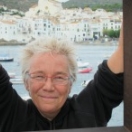
 Nan Buzard is being honored as a Champion of Change for her service to the American Red Cross.
Nan Buzard is being honored as a Champion of Change for her service to the American Red Cross.
What a wonderful surprise – and great honor - to be recognized as a White House Champion of Change on behalf of the American Red Cross. I lead the American Red Cross’ response to disasters around the world. Over the past seven years, it has been deeply satisfying to see our increased investment in preparedness, risk reduction and resiliency throughout our global programs. Disasters will always happen but families and communities can better withstand and recover if provided with preparedness opportunities ahead of time.
When you see the enormous toll disasters take – especially on highly vulnerable populations – you know we need to make larger investments in preparedness. Of course we can’t protect everyone from everything – but I have seen what better preparedness can accomplish and it is definitely worth serious focus and increased resources.
Directly following the March 2011 tsunami, the Japanese Red Cross asked me to join them in assessing their response and recovery operations and options. It was a profoundly sobering experience to see the destruction of hundreds of miles of coastline, with shattered villages and lives.
There is no question that many lives were saved due to the speed of the early warning system and tsunami alerts sent out after the quake. In addition, other factors such as strict building codes, fish markets equipped with high-rise platforms, and clearly marked escape routes saved lives too. Japanese children also practice tsunami drills and learn new procedures and survival techniques. Many of the children who survived put that information into practice. One of the most important lessons from Japan is that disaster mitigation measures and preparedness education pay off. And that is what the American Red Cross is dedicated to doing.
The International Services Department at the American Red Cross has been steadily increasing its commitment to disaster preparedness and disaster risk reduction. Those efforts serve two core purposes – better protecting vulnerable populations and with better cost efficiencies. We all know the scale and frequency of natural disaster are putting ever-greater pressure on the humanitariansystem. Disasters often result in significant loss of life and livelihoods and often require large amounts of humanitarian aid. Increasingly there is evidence that investing in the disaster resilience of communities is more cost-effective than humanitarian response when a crisis is in full swing. These investments can also lessen needless suffering and loss of life, and reduce the need for humanitarian aid. By saving lives as well as livelihoods, communities can also bounce back much more quickly when disaster strikes. This is what inspires me.
I came to the American Red Cross after years in the private sector and more than a decade of disaster response work including with the UN Refugee agency. I have been preoccupied with bringing private sector analysis, discipline and results to public sector work – and deeply committed to supporting the voice of disaster affected populations in determining their future.
I think disaster preparedness and risk reduction does that. When I look at the last seven years I see great progress at the American Red Cross in pursuing and delivering on such efforts. This includes working in a dozen highly disaster-prone countries in Asia on the Program for Enhanced Emergency Response. This program trains Red Cross volunteers and staff in first responder skills such as first aid and search and rescue. Through-out the Caribbean and Latin America, where hurricanes, flooding and landslides imperil people’s lives we are supporting communities in disaster evacuations drills, linking weather forecasting to early warning systems, encouraging good hygiene and sanitation practices, and supporting hazard resistant construction techniques. In Uganda, we are using GIS and global volunteers to map cities in order to provide the Red Cross and the local government with maps so that ambulances and taxis can more easily transport the ill and injured to hospitals.
And next month, the Red Cross is launching another project that will focus on collecting, consolidating and translating all the good disaster preparedness material available in the world. This effort will also aid in research to increase our collective understanding of what preparedness activities and approaches yield the greatest benefit to communities and provide technical assistance.
With over half the world’s population now living in cities, we must better understand how preparedness response and recovery works and engage at scale – not just in a few dozen cities or even hundreds of cities, but thousands. I am excited that the American Red Cross is thinking and acting to help address this need and know that we are and will continue to play a key role in helping people around the world.
Nan Buzard is responsible for the international disaster response and programs of the American Red Cross


